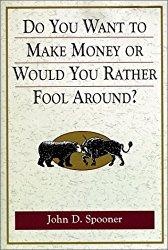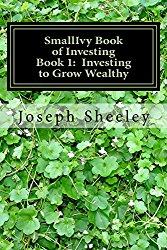Probably fifteen years ago, I found a book that really changed the way I invest and really made a difference. It was Do You Want To Make Money Or Would You Rather Fool Around ? by JD Spooner. About that time was when I shifted from what I had done through my youth to what I now call the Serious Investing strategy. It has made a huge difference in my investment returns. I started investing when I was twelve-years old. My father was a big investor and I used to watch him keep track of his stocks using the stock tables from The Wall Street Journal. He would diligently write the closing prices down each day, then make a chart of his stocks on graph paper. This was around 1982, when there really were no spreadsheets, let alone the internet. After talking about investing with him a bit, I decided that I wanted to take the $250 from my bank account and invest in stocks.
I started investing when I was twelve-years old. My father was a big investor and I used to watch him keep track of his stocks using the stock tables from The Wall Street Journal. He would diligently write the closing prices down each day, then make a chart of his stocks on graph paper. This was around 1982, when there really were no spreadsheets, let alone the internet. After talking about investing with him a bit, I decided that I wanted to take the $250 from my bank account and invest in stocks.
I bought 15 shares of Tucson Utilities for $15 per share. We got the stock certificate in the mail a couple of weeks later, which featured a picture of some goddess shooting lightning bolts from her fingers. I held the shares through high school and college. I actually went to undergraduate school in Tucson, so I became a customer of my company, which felt pretty neat. Along the way the stock went to about $80 per share and then collapsed when a scandal broke out at the company. The share price dropped to $4 per share, and then $2. I continued holding for several years. Eventually the company started paying dividends again. The share price recovered with time until the company was bought out. Overall I made a good profit on the position.
Hey – if you like The Small Investor, help keep it going. Buy a copy of SmallIvy Book of Investing: Book1: Investing to Grow Wealthy, buy one of the products shown, or just click on one of the product links and then browse and buy something else you need from Amazon’s huge collection. The Small Investor will make a small commission each time you buy a product through one of our links.
Rather than having me call home every few weeks asking for money for college expenses, my parents used the gift exemption each year when I was in high school to put money in a brokerage account for me. Actually, my father transferred shares of stock that he had into the account, which allowed the profits from the eventual stock sales to be taxed at my lower rate, rather than at his high rate. This was probably good and bad, in that it gave me a good start and financial security, but it also gave the opportunity for me to really mess things up since I was a young man with a fair amount of money available to throw at a whim.
For the most part I managed it well, not blowing the money on stuff as some late-teens, early twenty-somethings often would. I was actually able to make the account grow while I was in undergraduate college while using the account for rent, food, books, and other expenses. I had a state lottery scholarship that allowed me to go to college tuition-free, plus worked a job in a lab at school that paid about $400 per month. Grad school was more expensive, living in the San Francisco Bay area with higher rents and costs, so even though I was also able to go to grad school tuition-free and had a research assistant job that paid $1500 per month, the account started wasting away a bit and was fairly small by the time I graduated and got a regular job.

While I was fairly good with money management, I wasn’t that great at investing because I had lessons to learn. A big lesson was that people have no business buying options for speculating. During my sophomore year I was buying options on both some individual stocks and the S&P 500 and S&P 100 futures. I had planned to try option speculating with a certain amount of money, and actually ended up losing about twice that amount before all was said and done. Funny how easy it is to start throwing good money after bad, as the expression goes.
Besides doing really foolish things like trading options, a lesson I’d learned before I finished undergraduate school, I also wasn’t investing effectively because I was trading too much and not letting profits grow like I should have. My mind was filled with the idea that you need to “cut your losses short” and “protect your profits.” As a result I was selling stocks when I made a profit of $1000 and also selling them when I had a small loss (or sometimes a big loss, since stocks sometimes fall a lot before you can do anything). Taxes each year were a pain as well since I typically had 15-20 trades I needed to detail on my tax returns. Another issue I had was that I wasn’t buying in sufficient quantities to make much of a profit when I did get a winner since I had 100 shares each of maybe 20-30 stocks.
About then was when I found JD Spooner and his book, Do You Want To Make Money Or Would You Rather Fool Around ? From Spooner I learned that, if you are going to try to trade individual stocks, it is better to concentrate your investments in a few holdings than it is to buy a few shares of this and a few shares of that. If you are spreading your money out, you might as well buy mutual funds, which are cheaper and do a good job of diversifying your investments. Actually, you should use mutual funds for your core investments and then have a few individual stocks to try to increase your returns.
I then went from making a small amount off of my winners, maybe $2,500 off of a huge winner that went up 200% and that I didn’t sell just because I made $1,000, to making real, life-changing profits. I now buy large positions for my individual stock investing (my 401K and a good portion of my IRA is in index mutual funds, in case I don’t do that well with stock picking) and let those investments grow for several years. The only reason I sell is if the company has changed or the position has become so large that a loss would be devastating. (I typically cut a position in half if it grows to about 5% of my net-worth or more.)
This has made all the difference and I have actually been able to beat the markets over time since I started using this technique. There are some years when I lag the market, since I’m invested in a few companies and they don’t do well every year, but over a period of time I have done very well. This is not to say that I have not had some significant losses, since concentrating also makes your losses big when you choose poorly, but by letting my positions get big, but not big enough to be devastating, I can tolerate the risk.
Have a burning investing question you’d like answered? Please send to [email protected] or leave in a comment.
Follow on Twitter to get news about new articles. @SmallIvy_SI
Disclaimer: This blog is not meant to give financial planning or tax advice. It gives general information on investment strategy, picking stocks, and generally managing money to build wealth. It is not a solicitation to buy or sell stocks or any security. Financial planning advice should be sought from a certified financial planner, which the author is not. Tax advice should be sought from a CPA. All investments involve risk and the reader as urged to consider risks carefully and seek the advice of experts if needed before investing.
